Logger Killed While Attempting to Dislodge a Previously Felled Tree with Another Tree
FACE 97-AK-027
SUMMARY
A logger was killed while attempting to dislodge a previously felled tree by felling a second tree across it. The victim was one of two cutters that was transported by helicopter to their assigned work site on a steep, forested hillside. He was cutting the few remaining trees in his strip along a bluff. There were no witnesses to the incident, but the evidence indicated the victim was felling trees as he descended the hillside. The first tree in the incident (Tree #1) was felled over a rocky drop-off and became lodged in a lower stand of trees. He cut a second tree (Tree #2) to the side and slightly below the lodged tree. Tree #2 fell onto Tree #1. However, Tree #1 did not dislodge, causing the butt of Tree #2 to rebound. The victim was struck as the butt of the trunk of Tree #2 descended and swung toward the hillside.
When the victim did not arrive at the designated helicopter pick-up location for transport back to camp, contact by two-way radio was attempted. Failing to make radio contact, co-workers went to the victim’s last spotted position where he was found pinned between the hillside and the butt of the log. Alaska State Troopers and emergency medical technicians (EMTs) were notified and transported to the scene. Co-workers were able to free the victim and move him to a helicopter staging area where they were met by EMTs. The victim was pronounced dead at the scene.
Based on the findings of the investigation, to prevent similar occurrences, employers should:
- ensure that all cutters working on steep terrain fell trees according to safe methods in accordance with 29 CFR 1919.266;
- consider excluding trees that should not be felled for harvesting due to extreme terrain conditions.
INTRODUCTION
At approximately 2:00 PM on August 01, 1997, a 35 year old male logger (the victim) was fatally struck by the trunk of a tree he fell (cut) to dislodge a previously felled tree. On August 04, 1997, Alaska Department of Labor (AK-DOL) notified the Alaska Division of Public Health, Section of Epidemiology. An investigation involving an Injury Prevention Specialist for the Alaska Department of Health and Social Services, Section of Epidemiology ensued on August 04, 1997. The incident was reviewed with AK-DOL officials. Alaska State Troopers and Medical Examiner reports, as well as AK-DOL reports, were requested.
The company in this incident was a privately owned logging operation that had been in business for 24 years. The company currently had 396 employees. The victim was an experienced cutter and had been employed by the company for five weeks.
The company had a written employee’s manual that included safety rules and practices for camp and work. In addition, employees received a copy of the Alaska Timber Insurance Exchange logging safety handbook. Safety meetings were held at least monthly. All employees were required attend an initial hire orientation and CPR and first aid training, if necessary. In addition, employees were assessed for individual skills and knowledge by the cutting supervisor or “bullbuck.” Intermittent observations were made while working in their assigned area to provide recommendations and corrective actions including re-assignment, if necessary. This was the second fatality for the company. The first fatality was a heli-logging incident in 1996.
INVESTIGATION
The incident occurred at a site on a steep, remote hillside in southeast Alaska, approximately 4 air miles from the main camp. The logging operation transported workers, including cutters and choke-setters, to various work site staging areas by helicopter. The staging areas were located either above or below steep hillsides that have had sections or strips of timber marked for manual cutting. Each cutter carried a small emergency first aid packet, personal protection equipment, and logging equipment. In addition, cutters were required to carry a two-way radio while working alone or “single jacking” unless voice and visual contact could be maintained among co-workers.
The primary type of harvesting undertaken by the logging operation was clearcut. The terrain of the harvest area varied in slope, altitude, and ground conditions. The incident site was located on a slope of approximately 80 degrees and less than 2,000 feet in altitude. The ground conditions consisted of moderate to heavy brush with occasional large rocks and rock outcroppings. Forest composition consisted of conifers. Tree #2 in this incident was hemlock, approximately 100 feet in height with a stump diameter of 23 inches. The weather was mostly clear with an occasional shower and not considered a factor in this incident.
Upon completion of a site survey, the cutting supervisor or bullbuck assigned stands of naturally occurring timber to individual cutters. The victim’s assigned stand ran down a steep hillside, adjacent to a rocky drop-off. The few remaining trees in the stand were located near this area.
On the day of the incident, the victim had been working approximately 3 hours at another site prior to going to the top of the previously assigned strip. He had discussed the few trees left along the edge of the strip with the bullbuck on the preceding work day and was single jacking to fell these remaining trees. He was last seen at approximately 1:30 PM at the top of his assigned area by a helicopter pilot.
Since the incident was not witnessed, it was surmised from the evidence that the victim decided to fell trees as he descended the hillside from his original drop-off point to the planned pick-up location at the bottom of the hillside. The victim had felled Tree #1 from the top of a rocky drop-off in the direction of a lower stand of timber (Figure 1a). The tree became lodged as the branches arrested its fall through the stand. Now having a hazardous condition in his planned route, the victim then went to Tree #2 approximately 30 feet away and slightly below Tree #1. The location of Tree #2 was on the brink of a ledge, located 3 to 4 feet below a near-vertical incline (Figures 2a and 2b). As viewed from the front of the ledge, the ledge extended back approximately 2 feet and approximately 3 feet along the hillside to the right of Tree #2, tapering into the hillside. The ledge also extended to the left, approximately 3 feet, behind an adjacent rock and ended by merging into the natural slope. This area was wide enough to allow passage between the hillside and the rock but was partially obstructed by branches (Figure 3).
The victim made two standard cuts to fell Tree #2, a Humbolt undercut (a notch cut in the direction of the intended fall) and a backcut (the final cut on the opposing side) (Figure 4). Due to the close proximity of the rock, the victim positioned himself to the right of the tree to make the cuts (Figure 2a). This position placed the victim in the direction he intended the tree to fall (Figure 1b). An escape route was not apparent. Brush and branches in the immediate area had not been cleared (Figure 3).
Upon completion of the cuts, Tree #2 fell and struck the lodged tree. However, the impact did not dislodge the tree. The trunk of Tree #1 acted as a pivot, allowing the butt of Tree #2 to rebound. The victim was struck as the butt descended and swung toward him as it continued to slide down the trunk of the lodged tree.
At approximately 2:30 PM, the victim had not yet arrived at the designated helicopter staging area for transport back to camp and was not responding to his radio. Co-workers, hiking back to the last spotted position, found the victim approximately 3 feet from the stump, pinned under the newly fallen log against the hillside. No pulse or signs of breathing were apparent. Emergency medical services were notified, and a medivac flight was dispatched from Ketchikan. The log was lifted by helicopter, at which time the victim slid down the slope. He was recovered, placed in a Stokes litter, and transported by helicopter to the main staging area where it was met by emergency medical technicians (EMTs). At 4:24 PM, the victim, having remained unresponsive and not exhibiting any vital signs, was pronounced dead at the scene.
CAUSE OF DEATH
The medical examiner’s report listed the cause of death as massive crush injuries.
RECOMMENDATIONS/DISCUSSION
Recommendation #1: Employers should ensure that all cutters working on steep terrain fell trees according to safe methods in accordance with 29 CFR 1919.266.
Discussion: In this incident, the victim chose to begin felling trees from the top of the slope as he proceeded down the hillside to the planned pick-up location. 29 CFR 1919.266(h)(1)(viii) states “Felling on any slope where rolling or sliding of trees or logs is reasonably foreseeable shall be done uphill from, or on the same level as, previously felled trees.”
Secondly, the victim did not clear an accessible escape route. However, the victim’s position following the incident (Figure 1b) suggested the victim may have intended to escape from the ledge by climbing up the 3- to 4-foot, near-vertical incline. 29 CFR 1910.266(h)(2)(i) states “Before felling is started, the feller shall plan and clear a retreat path. The retreat path shall extend diagonally away from the expected felling line unless the employer demonstrates that such a retreat path poses a greater hazard than an alternative path. Once the backcut has been made the feller shall immediately move a safe distance away from the tree on the retreat path.” Employers should ensure all cutters properly plan and clear an accessible route for escape opposite the direction of fall before initiating the cut.
Recommendation #2: Employers should consider excluding trees that should not be felled for harvesting due to extreme terrain conditions.
Discussion: While clearcutting removes all harvestable trees on accessible terrain, the topographic characteristics within a marked timber strip may prohibit safe felling practices. In particular, the degree of inclination of the slope, characteristics of immediately surrounding terrain (e.g., outcroppings, ledges), and the ability to execute a planned escape route, should be evaluated during the site survey to identify exempt cutting areas. Excessive damage to the felled tree(s) and potential control of slope erotion may be additional factors to consider when evaluating areas to be exempt from standard clearcut practices. Cutters need to exercise caution when felling trees in extreme terrain conditions. If a tree cannot be safely felled, presenting an unacceptable risk to the cutter, the tree either should either be left standing or marked for an explosive charge.
References
- Conway S. Logging practices: principles of timber harvesting systems. Rev. ed. San Francisco: Miller Freeman Publications, 1982.
- Fallers’ and buckers’ handbook, 9th Ed. Vancouver, Canada: Workers’ Compensation Board of British Columbia, 1990.
- Logging from felling to first haul. Criteria document for a recommended standard. US Dept of Health, Education and Welfare publication no. (NIOSH) 76-188, 1976.
- Logging safe practices guide, Alaska Timber Insurance Exchange.
- Office of the Federal Register: Code of Federal Regulations, Labor 29 Part 1910. Washington, DC: U.S. Government Printing Office, 1996.
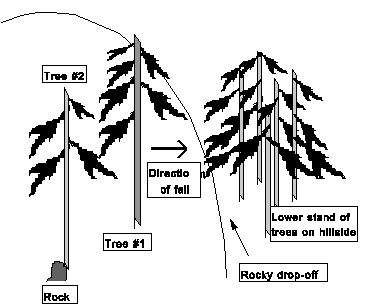
|
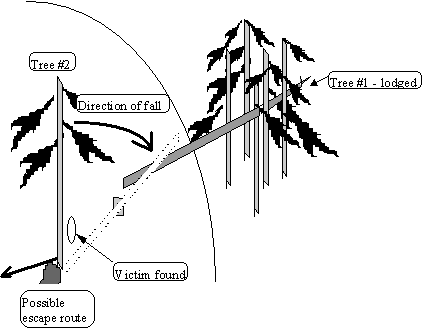
|
| Figure 1a. Aerial view of tree positions on hillside | Figure 1b. Position of victim relative to Trees #1 and #2 |
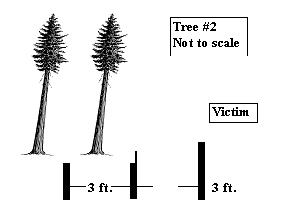
|
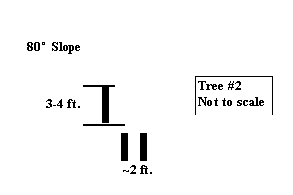
|
| Figure 2a. Front view of ledge | Figure 2b. Side view from right side of ledge |
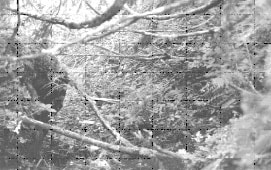
|
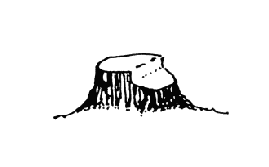
|
| Figure 3. View of unbrushed ledge undercut | Figure 4. View of Humbolt |
To contact Alaska State FACE program personnel regarding State-based FACE reports, please use information listed on the Contact Sheet on the NIOSH FACE web site Please contact In-house FACE program personnel regarding In-house FACE reports and to gain assistance when State-FACE program personnel cannot be reached.
